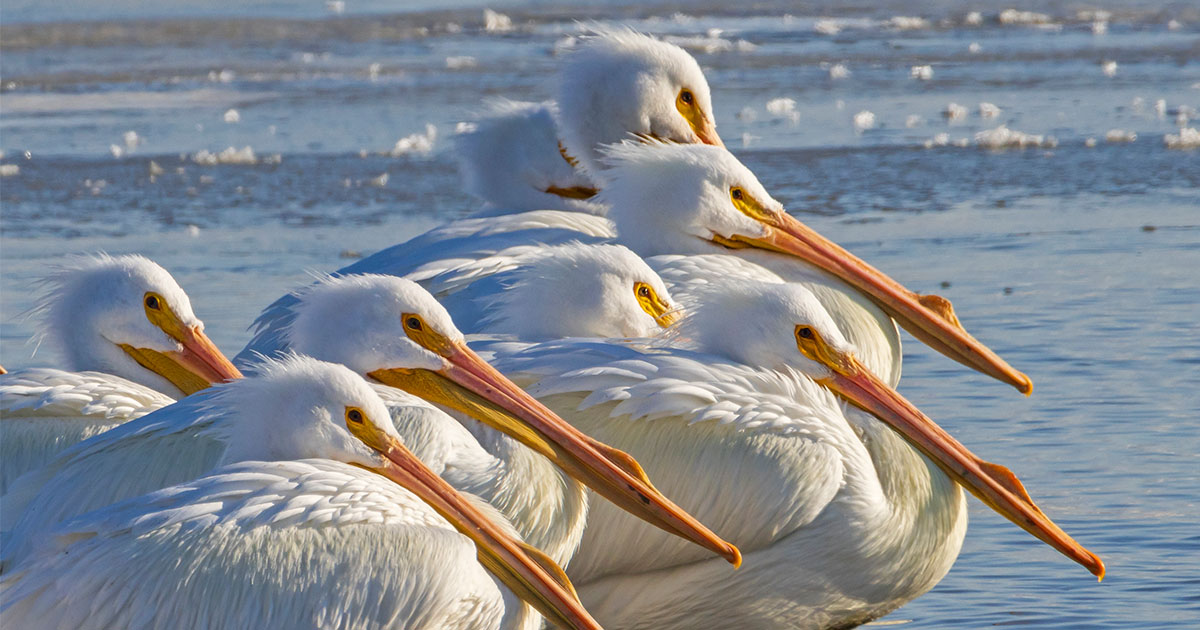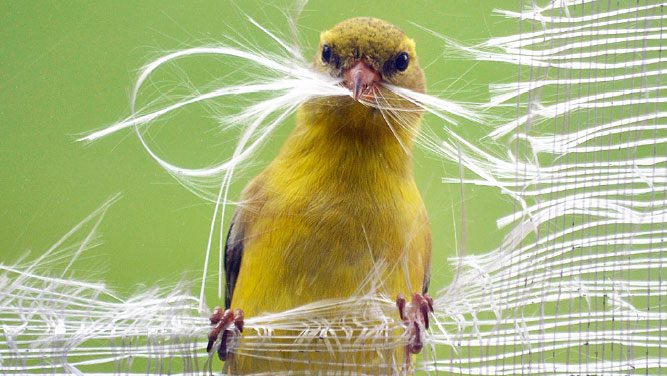July 17th, 2024, 4:45 a.m.
Long before sunrise, under hazy streetlights, I joined dozens of blurry eyed biologists, volunteers, members of the media, Utah Division of Wildlife (DWR) staff as well as other Utah Department of Natural Resources (DNR) employees, at the DNR headquarters in Salt Lake City. We braved the early morning hours for the opportunity to do something that hasn’t been done since 2019: make the trek out to Gunnison Island in the North Arm of Great Salt Lake to band American White Pelicans.
This charismatic species of “mega avifauna” are emblematic of Great Salt Lake, with 20,000 breeding adults (one of the largest nesting colonies in western North America) historically nesting on Great Salt Lake’s islands, including Gunnison Island, tucked away in the north arm. American White Pelicans seek out the hostile, dry, and remote conditions at places like Gunnison for safety and refuge to raise their young, making ~60–100-mile daily round-trip commutes to freshwater wetlands on the eastern side of Great Salt Lake, and even reservoirs high up in in the Wasatch mountains to forage for fish to feed their chicks.
Low lake levels over the past few decades have formed land bridges making most—sometimes all—of the islands of Great Salt Lake into peninsulas. Audubon, state biologists, and partners have raised concerned for years, as predator (especially coyotes) access to the islands could lead to the collapse of colonial nesting waterbirds, like pelicans.
From 2014-2023, American White Pelican numbers at Great Salt Lake have dwindled by more than 50 percent with nesting populations only reaching an average of 8,500. The land bridge at Gunnison Island in particular, has allowed coyotes and other predators to access the island for years, pushing the pelicans into the most remote bays of the island in the northwest corner. Consequently, during an aerial phalarope survey in 2023, DWR biologists confirmed that the concern shared by so many had become a reality: the pelicans had abandoned their Gunnison colony that year.
Fast forward to May 2024, Great Salt Lake levels in the south arm rebounded after a record-breaking snowpack in the winter of 2022-23 and an above average snowpack in 2023-2024. The north arm water levels sit at about 4192 feet. Despite the continued existence of the land bridge, this year’s annual pelican survey held very promising news. DWR found that not only had the pelicans returned to Gunnison to nest in 2024, but for the first time in 80 years, they also returned to nest at Hat Island, located in the northwest portion of Gilbert Bay in the south arm of Great Salt Lake.
During the initial nesting survey in May of this year, 1200 nests were documented on Gunnison Island, and 1900 on Hat Island. Each nest initially has two eggs, but if both eggs hatch, one chick is larger than the other and outcompetes its sibling and usually only one chick survives. In general, this means that one nest equals one chick. John Neill, Wildlife Biologist for the DWR confirmed that from the time the pelicans nest to their final survey at the end of July, typical survival rate for pelican chicks is about 40 percent. This would mean, that for the 3100 nests at Great Salt Lake this year—with luck—about 1200 chicks will fledge from Great Salt Lake’s Islands. Banding a percentage of the pelicans will also help the state better understand the survival rate of this year’s chicks.
After the colony collapse of 2023, an outbreak of Bird flu in 2022, and the pandemic impacting 2020-2021, the last effort to band American White Pelicans on Gunnison Island occurred in 2019. The five-year hiatus left the dozens of volunteers and biologists geared up for the trek in giddy anticipation in spite of the early morning hours. The trek to Gunnison is not for the faint of heart—in addition to the early morning start, the trip requires a 90-mile drive out to the far west side of Great Salt Lake followed by another 14-mile drive in ATVs across dikes and the lakebed of the north arm.
The 2.5 hour one-way trip has such an early departure time to ensure that our team can band the pelicans before the scorching summer midday heat. Yet the journey felt worth it as the landscape was otherworldly with vast, seemingly endless stretches of salt-encrusted lakebed. A truly remote location.
The Utah DWR team leading the way has the event coordination down to a science.
Step One: The Pelican Roundup
Once we made it to the southern tip of the island, we gathered to prepare for the “pelican round-up”. Armed with radios and temporary fencing supplies, the group broke into two teams. The first team went over the ridge to prevent the pelicans from scurrying up into the cliffs and rocky outcroppings, where they are at risk of injury. I joined the second team, with the goal of sneaking around the rocky corner of the island’s bay, running along the shoreline to prevent the pelicans from escaping into the saturated salty waters of the north arm, where the buildup of salt crystals on feathers can also harm the young pelicans. After about 20 minutes, we had a group of 100 or so young but feathered pelicans surrounded.
Young pelicans at this age are almost as large as their parents, but still cannot fly. After a certain age, they leave their individual nests and group up to form a pod. Waddling very much like penguins, the parading pod of pelicans was slowly herded into a temporary enclosure. From that point, team members took turns collecting individual pelicans and carrying them off to a group of 6 professional banders.
Step Two: The Capture
There is a technique to apprehending a pelican by hand. The big trick is to get control of their bill so they cannot lunge and put the handler at risk of being caught by the sharp point at the tip. (Once the handler has control of their bill, they have to get a finger or two inside of the bill to hold it partly open as keeping the bill and mouth closed completely puts them at risk of suffocating. With control of their bill in one hand, the handler simply reaches their other hand around the pelican’s body and wings to gain complete control and pick them up. Easy, right? (Wrong. Just ask one Utah state biologists with a permanent pelican-inflicted scar on his cheek.)
Step Three: Pelican Processing
Each young pelican was equipped with a silver USGS leg tag with a unique identification number on the left leg, and a black MOTUS tracking tag on the right. Once their new jewelry was installed and data was gathered, the pelicans were released one-by-one back onto the island. Overall, the team was very efficient in the banding effort with the entire process taking about one minute per bird, and the team reaching the goal of deploying 70 MOTUS tags in the span of an hour.
Handling my first pelican held many surprises:
-
Their bills are much softer and more flexible than I expected, and I was careful to be delicate.
-
They didn’t weigh quite as much as I thought once in hand, but are also a large and bulky bird compared to others I have handled.
-
They can be rather sassy birds. A few individuals tried to lunge at their capturers after being released, though mine was calm the entire time I handled it and quickly scooted away after the banding process was complete.
-
Pelicans deserve appreciation. The whole experience made me appreciate pelicans much more, and helped me realize they each have unique personalities.
At the end of July, Utah DWR will repeat this same banding process at Hat Island. The state of Utah has banded pelicans for years using various methods, from patagial wing tags with large visible numbers, to small GPS backpacks to help them better understand their movements and migration. This year’s tags, utilizing new and much less intrusive MOTUS technology, will allow the State of Utah and partners to see how pelicans move across their range using the infrastructure of MOTUS radio towers that ping a radio signal when an individual gets within a certain radius of the tower.
The hope is that this year’s pelican banding effort, combined with this new technology, will provide insights into where Great Salt Lake’s pelican chicks are going and how they are doing, furthering our ability to conserve and sustain Great Salt Lake’s pelican populations. I personally can’t wait to see where my new pelican friend will go over the course of the year.



